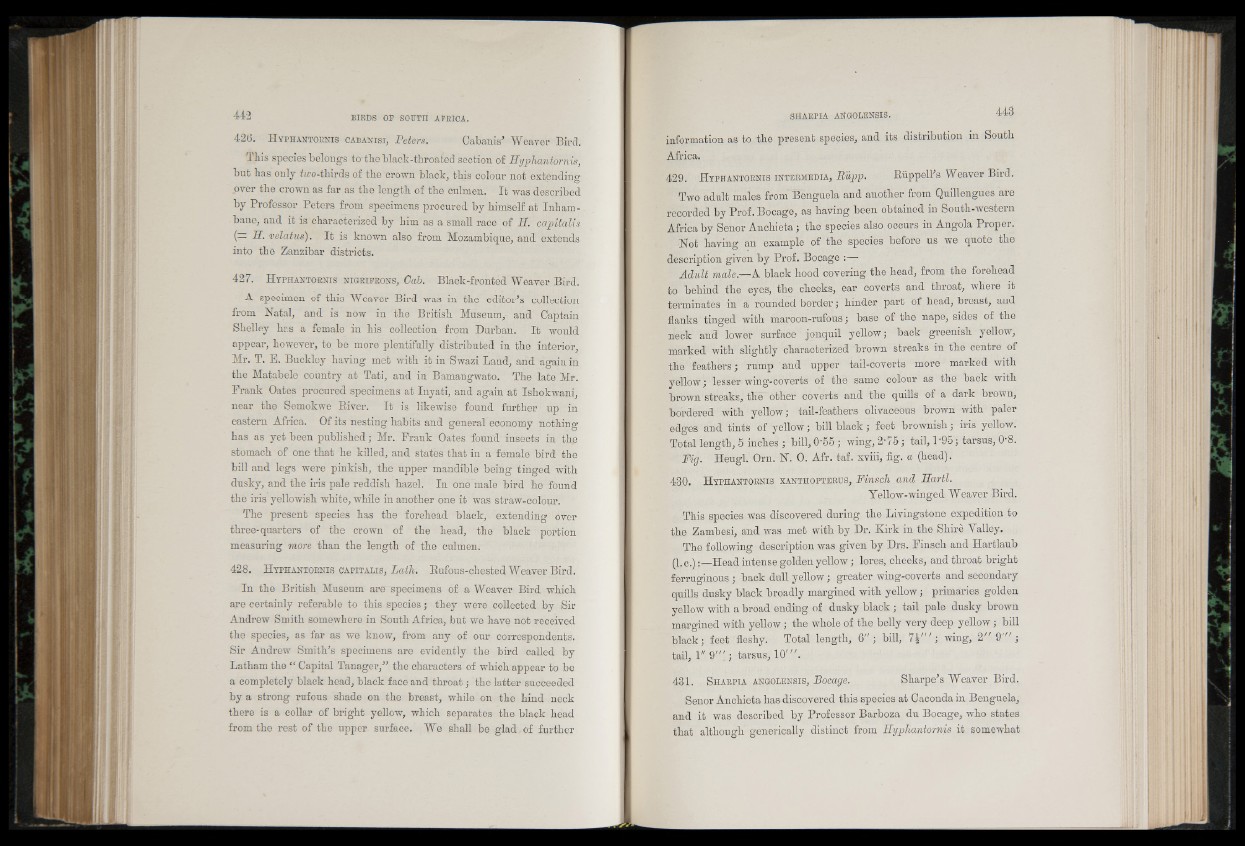
426. H y p h a n t o r n is c a b a n is i, Peters. Cabanis’ Weaver Bird.
This species belongs to the black-throated section of Eyphantornis,
but has only two-tliirds of the crown black, this colour not extending
over the crown as far as the length of the cnhnen. It was described
by Professor Peters from specimens procured by himself at Inham-
bane, and it is characterized by him as a small race of H. capitalis
(— S . velatus). It is known also from Mozambique, and extends
into the Zanzibar districts.
427. H y p h a n t o r n is n ig r ie r o n s , Gab. Black-fronted Weaver Bird.
A specimen of this Weaver Bird was in the editor’s collection
from Natal, and is now in the British Museum, and Captain
Shelley has a female in his collection from Durban. It would
appear, however, to be more plentifully distributed in the interior,
Mr. T. E. Buckley having met with it in Swazi Land, and again in
the Matabele country at Tati, and in Bamangwato. The late Mr.
Prank Oates procured specimens at Inyati, and again at Ishokwani,
near the Semokwe Eiver. It is likewise found further up in
eastern Africa. Of its nesting habits and general economy nothing
has as yet been published; Mr. Prank Oates found insects in the
stomach of one that he killed, and states that in a female bird the
bill and legs were pinkish, the upper mandible being tinged with
dusky, and the iris pale reddish hazel. In one male bird he found
the iris yellowish white, while in another one it was straw-colour.
The present species has the forehead black, extending over
three-quarters of the crown of the head, the black portion
measuring more than the length of the culmen.
428. H y p h a n t o r n is c a p it a l is , Lath. Eufous-chested Weaver Bird.
In the British Museum are specimens of a Weaver Bird which
are certainly referable to this species; they were collected by Sir
Andrew Smith somewhere in South Africa, but we have not received
the species, as far as we know, from any of our correspondents.
Sir Andrew Smith’s specimens are evidently the bird called by
Latham the “ Capital Tanager,” the characters of which appear to be
a completely black head, black face and throat; the latter succeeded
by a strong rufous shade on the breast, while on the hind neck
there is a collar of bright yellow, which separates the black head
from the rest of the upper surface. We shall be glad.of further
information as to the present species, and its distribution in South
Africa.
429. H y p h a n t o r n is in t e r m e d ia , Rupp. Riippell’s Weaver Bird.
Two adult males from Benguela and another from Quillengues are
recorded by Prof. Bocage, as having been obtained in South-western
Africa by Senor Anchieta; the species also occurs in Angola Proper.
Not having an example of the species before us we quote the
description given by Prof. Bocage :—
Adult male.—A black hood covering the head, from the forehead
to behind the eyes, the cheeks, ear coverts and throat, where it
terminates in a rounded border; hinder part of head, breast, and
flanks tinged with maroon-rufous; base of the nape, sides of the
neck and lower surface jonquil yellow; back greenish yellow,
marked with slightly characterized brown streaks in the centre of
the feathers; rump and upper tail-coverts more marked with
yellow; lesser wing-coverts of the same colour as the back with
brown streaks, the other coverts and the quills of a dark brown,
bordered with yellow; tail-feathers olivaceous brown with paler
edges and tints of yellow; bill black; feet brownish; iris yellow.
Total length, 5 inches ; bill, 0'55; wing, 2-75; tail, 1 '95; tarsus, 0'8.
Fig. Heugl. Orn. N. 0. Afr. taf. xviii, fig. a (head).
430. H y ph a n t o r n is x a n t h o p t e r u s , Finsch and Eartl.
Yellow-winged Weaver Bird.
This species was discovered during the Livingstone expedition to
the Zambesi, and was met with by Dr. Kirk in the Shire Yalley.
The following description was given by Dr s. Einsch and Hartlaub
(1. c.):—Head intense golden yellow; lores, cheeks, and throat bright
ferruginous ; back dull yellow; greater wing-coverts and secondary
quills dusky black broadly margined with yellow; primaries golden
yellow with a broad ending of dusky black; tail pale dusky brown
margined with yellow; the whole of the belly very deep yellow; bill
black; feet fleshy. Total length, 6"; bill, 7 ^ " ; wing, 2" 9 '" ;
tail, 1" 9 " (; tarsus, 10"'.
431. S h a r p ia a n g o l e n s is , Bocage. Sharpe’s Weaver Bird.
Senor Anchieta has discovered this species at Gaconda in Benguela,
and it was described by Professor Barboza du Bocage, who states
that although generically distinct from Eyphantornis it somewhat